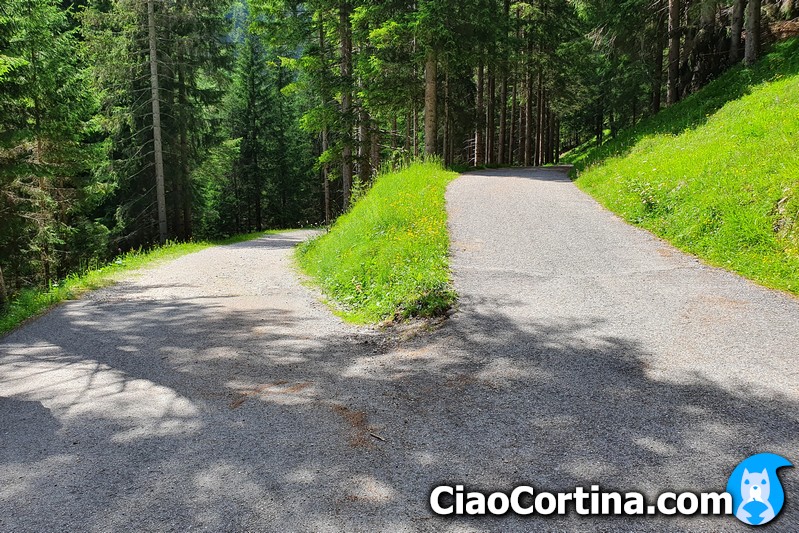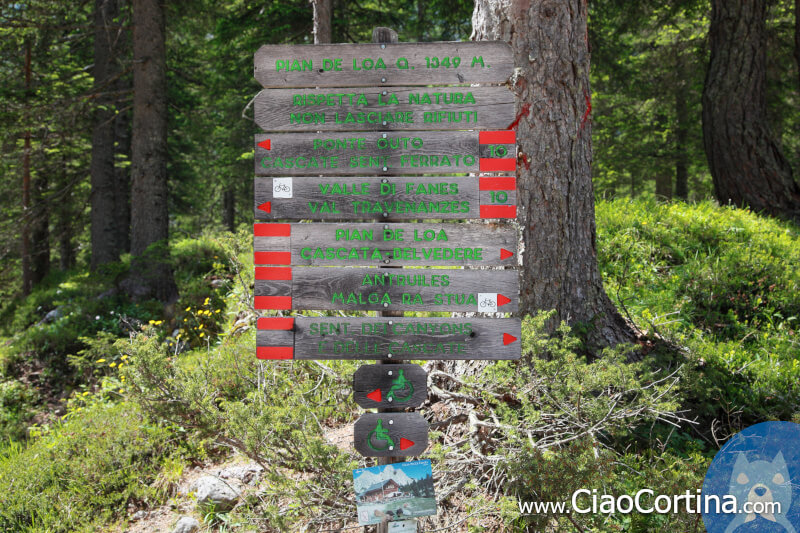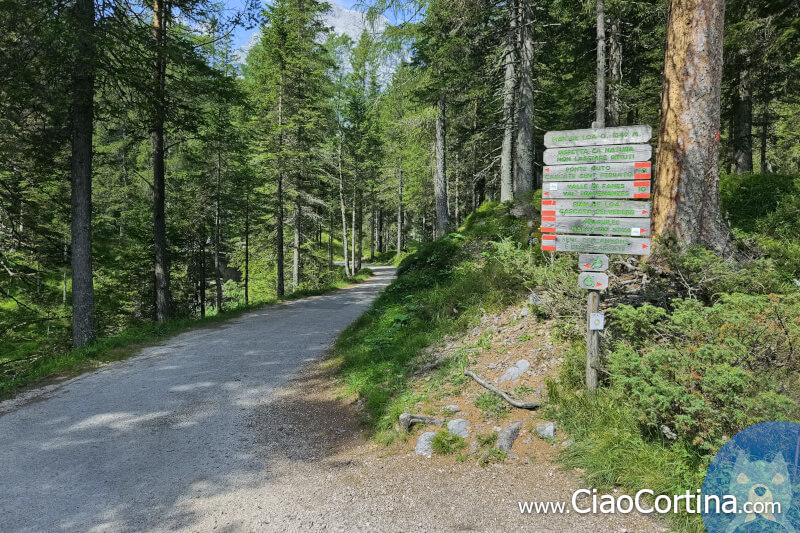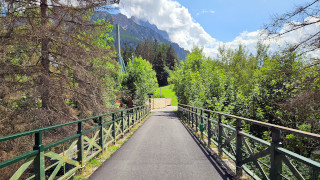Overview
Map

Introduction
The hike of the Lower "Fanes" Falls is quite a challenging walk, with a length of about ten kilometers, or six miles, that starts and ends in the locality of "Fiames". The hike to the Fanes Waterfalls is a wonderful walk that will take you about three hours, with a difference in altitude of around five hundred meters, or sixteen hundred feet.

You can find this hike to the Lower "Fanes" Waterfalls on the Tabacco Map 003 - "Cortina d'Ampezzo Dolomiti Ampezzane." It goes along Path 10, with a deviation on the Path of Canyons and Waterfalls. Alternatively, you can see our route on Google Maps by clicking here.
This hike is suitable for everyone that is reasonably trained, but it could be made more challenging by taking an optional variation that needs climbing harnesses and carabiners. Alternatively, it is also possible to shorten the length while still remaining a scenic and satisfying walk. On the page, however, we will describe all the variants.
 Help us stay ad-free with a small offer.Donate now!
Help us stay ad-free with a small offer.Donate now!
Path of the Hike
The Lower Fanes Falls Hike begins at the free parking lot of Ampezzo's Dolomites Park. If you are unsure of how to reach it, we will describe it in depth down on the page in the chapter "How to Get There."

Once you've parked your car, head towards the tourist information wooden hut, cross the bar that blocks the cars, and start walking along Path 10. After a few meters, on your right, you'll see a suggestive gorge, called "Forra del Felizon," that has been dug by the flow of the "Felizon" stream.

After about one hundred meters, or three hundred feet, you will see the intersection of the "Felizon" Bridge. Take the road to the right, continuing along Path 10 towards "Cascate, Val di Fanes, Val Travenanzes." It means Waterfalls, "Fanes" Valley, and "Travenanzes" Valley.

The walk continues on an asphalt road for about thirty minutes, alternating uphills with downhills. Along this part of the walk, you will see some nice botanical signs describing the plants that grow along the road, as well as some benches where you can stop and relax.

You will see a small bridge; proceed along the asphalt road for ten minutes more. You will end up in the intersection of "Pian de Loa." It is easily recognizable by the bench and the signpost "Pian de Loa," 1349 m. Take the road to the right, in the direction of "Cascata - Belvedere - Sent. dei Canyons e delle Cascate." It means "Fanes Falls, viewpoint, Path of Canyons and Waterfalls."

We decided to take this newly created detour to allow you to see the Fanes Falls from a new and very scenic perspective and then turn back and continue, from here, to the bridge called "Ponte Outo." For those who wish to shorten the walk a little, it is possible to go directly to the left, in the direction of the "Ponte Outo."

So, we are at the intersection of "Pian de Loa." Take the road right and walk along the flat gravel road for about ten minutes. You will reach a large glade with a small mountain hut called "Cason de Pian de Loa."

From here you need to take the left, following the signs towards "Cascata di Fanes - Belvedere - Sent. dei Canyons e delle Cascate." From here the path enters the woods, gradually becoming narrower and slightly steeper, but always remaining clearly visible.

After about half an hour, the path will make a sharp bend to the right, becoming steeper. You have almost arrived at the viewpoint, ten more minutes and you will see it on the horizon.

Once you've reached the viewpoint, the majestic Lower Fanes Waterfall will stand out in front of you. If you have a fear of height, the area has been secured, and there is a railing to make you feel safe.

If you have the necessary equipment for a via ferrata you could continue along the narrow serpentine canal that you just left behind. This, in fact, is the Canyon and Waterfall Trail of which we talked about earlier.

This path, which we will not do, descends to the iron bridge that you can see further down, at the base of the waterfalls, and then climbs up until passing right behind the waterfall. We want to reiterate that it is a technical and rather dangerous route, recommended only for expert hikers equipped with climbing harnesses, carabiners, and hiking shoes.

Our itinerary is much simpler, suitable for those looking for a more relaxing hike, for those with children, or for those who suffer from vertigo. Don't worry about the missed opportunity; even with our variant, it will be possible to pass behind the waterfall along the optional via ferratas "Giovanni Barbara."
Retrace your steps until you reach the intersection of "Pian de Loa," 1349 m, the same place from where we took this detour. It should take you about half an hour. If you are tired and you are not interested in walking anymore and passing under the waterfall, you could even go back to the car.

Once you reach the crossroads, turn right, following the direction "Ponte Outo" - "Valle di Fanes." It means "High Bridge, Fanes Valley." From here you would probably stop for a moment to take a look at the "Rü de Fanes," the stream just behind the crossroads, which could be a beautiful place to rest a bit and gather your energy.

Once you cross the stream, you will find a road that goes into the woods. Initially it will be flat, but the slope will progressively increase, but it never becomes excessive. After about thirty minutes, you will see the bridge called "Ponte Outo."

The bridge stands on a ravine dug by the stream "Rü de Travenanzes." The name "Ponte Outo" literally means "high bridge," in the local dialect. Now that you're on it, you surely don't have doubt about the reason for this name.

After you've observed the view, continue another hundred meters, or three hundred feet, until you reach a rest area with a bench. From here you can enjoy a breathtaking view of the valley below. If you look carefully, you can even see the viewpoint you went to before.

Our hike ends here, but if you want a final thrill, from here, you can take the via ferrata "Giovanni Barbara," indicated by the sign "Sentiero Attrezzato alla Cascata," which means "Aided Path to the Waterfall."

This is an easy but very exposed path to be tackled with the help of a climbing harness. It is strongly not recommended for those who suffer from vertigo, those who accompany children, or those who are not equipped at least with a rope, carabiners, and experience.
If you decide to tackle it, in ten minutes you will reach the Lower Fanes Waterfall, which offers the possibility of passing under the waterfall. Remember to bring a waterproof jacket, as the temperature is significantly lower than on the path, and the mist will give you a nice refreshing sensation.

Once you are happy and you've passed under the waterfall. From there, retrace the road until you reach the car again. It will take you approximately an hour.
The hike on this page is the Low Waterfalls of Fanes. If you want to tackle a slightly more challenging walk, once you reach the bridge called "Ponte Outo," you can continue along Path 10 and reach the High Waterfalls of Fanes.
What you have just faced is part of the canyon and waterfall trail. If you want to tackle a more challenging hike, once you have reached Ponte Outo, you can continue along Trail 10 and tackle the second part of the trail, towards Sbarco de Fanes. We talked about it on the page dedicated to the high waterfalls of Fanes:

 Help us stay ad-free with a small offer.Donate now!
Help us stay ad-free with a small offer.Donate now!
Curiosities
There is a legend around "Ponte Outo," translated as "high bridge." It narrates the exploits of the Great Bracun. This knight seems to have been the noble "Francësch Wilhelm de Brach." He had to go to visit his girlfriend in "Podestagno," a nearby location. The owners of the nearby pastures were pissed by his continuous riding on the lands, so they decided to play a cruel joke on him. After cutting the supports of the bridge on the "Rü de Travenanzes," the shepherds hid to see the knight fall disastrously into the ravine. Thanks to a brilliant intuition, the Great Bracun understood that there was something strange, so he spurred his steed and, with a powerful leap, he crossed the tampered bridge, thus entering legend.

Regarding the legend we described above, on the "Ponte Outo," was displayed a painting depicting the jump of the Gran Bracun. It was commissioned by Alfred Mutschlechner, the historical owner of the Rifugio Fanes, and it was displayed around 1930 but was removed during a subsequent renovation of the bridge.
During your hike, you may have noticed that some trees have been carved by the black woodpecker. It is the largest specimen in Europe; it uses its strong beak to dig the wood in search of insects, contributing to the control of tree parasites. This bird had almost disappeared from Cortina, but it has returned to populate the Ampezzo woods, including those you have just walked, in the last decades. The most affected tree can be seen just before the intersection of "Pian de Loa," marked by a descriptive sign.
 Help us stay ad-free with a small offer.Donate now!
Help us stay ad-free with a small offer.Donate now!
How to Get There
Our version of the walk of the "Lower Fanes Falls" begins at the free parking lot of the Ampezzo's Dolomites Park, near the small wooden house that serves as the Park Information Point. The best way to get there is with your car; from the center of Cortina, you will need around 15 minutes.
As this is the starting point of many hikes, you should get there early in the morning if you want more chances to find a free spot, if it's peak season. If you can't find a free parking space, there's a second parking lot that might go unnoticed, located exactly here.
Another solution might be to take bus n°1 from Cortina's bus station and get off at the "Hotel Fiames," which is also the end of the line. From here you can take a wooded road toward the north, which, in about thirty minutes, will take you to the car park. The road can be easily spotted from the bar blocking the traffic and from the sign that says "Bosco dell'Impero," which indicates the Val di Fanes.
For more information and to purchase tickets, you should contact the ticket office, which is located in the same office as the Tourist Information Center. It may be closed during lunch.
This walk is already quite challenging, but you may still decide to walk from the town center to the starting point of the hike. In this case, you'll need to walk two hours more along the walk known as the former railway. In Italian we call it "Ex Ferrovia."
We have described this pleasant walk on a specific page, which you can visit by clicking below:

If you don't have a car, you may also consider a taxi. From Cortina to "Fiames," the price should be approximately €30, but it is better to ask the price beforehand, as this is a very rough estimate. You can find a taxi both in Piazza Roma, at the bus station, or using their website.
For any doubts you may have, you can consult the Tourist Information office in the center of Cortina.
 Help us stay ad-free with a small offer.Donate now!
Help us stay ad-free with a small offer.Donate now!
Useful information
This is one of the few hikes that we describe that does not have a mountain lodge to welcome you at the arrival. We advise you to prepare a packed lunch or plan the walk on a full stomach. If you want to eat out in Fiames, you will find a nice place, the "Hotel Fiames," where you can eat something both inside or on the terrace. Alternatively, you can also stop at the "Chalet Spiaggia Verde," where you can drink or eat something, and you will also possibly rent a sunbed to relax on the banks of the "Boite" Stream. We have never tried the restaurant under the new management. Although it is always crowded during peak season, it may be advisable to read some reviews first.
The walk to the lower waterfalls of Fanes and the small via ferrata behind the waterfall are not practicable in winter and are not recommended in case of rain. The rain makes the surfaces slippery; considering that some points are exposed, it's a good idea to avoid it. In winter the ice created by the waterfalls makes the route very dangerous; furthermore, the cross-country track crosses the first part of the route, and, by regulation, it is forbidden to walk or use snowshoes on the ski slopes.
The best period to do this hike is summer, as the presence of nebulized water will cool you off from the high temperatures. This walk is also very beautiful in spring, thanks to the thaw that supplies the waterfalls with water. The best month for the high water flow is probably May, but unfortunately it is not possible to know in advance when the snow will melt.
Even though this hike is pretty simple, if you avoid the via ferratas, we always recommend that you use appropriate clothing, starting with your shoes, which should be sturdy. Always carry a backpack with, at least, some water, a snack, and a rain jacket. If you are new to hiking, we recommend you read the page we wrote on how to tackle a mountain outing:

We want to emphasize that, in the territory of the Dolomites, there are rules to be followed. The main ones are:
- It is strictly forbidden to light fires.
- It is strictly forbidden to pick plants and flowers.
- Free camping is prohibited.
- It is prohibited to abandon garbage.
- It is mandatory to keep pets on a leash.
Always be responsible and when in doubt, stop. CiaoCortina cannot be held responsible for any damage to things or people, variations, wrong paths, errors, or inconveniences that may occur along the route. For more information, click here.
 Help us stay ad-free with a small offer.Donate now!
Help us stay ad-free with a small offer.Donate now!
Conclusion
We hope you liked this page on the hike to the Lower Fanes Waterfalls. Before saying goodbye, we would like to mention that you can find other amazing hikes in Cortina and its surroundings by clicking here.
If you want to thank us, you can read the page Support Us. If you only want to suggest a change, propose something, or just say hello, in the section Contacts and Info, you'll find all the ways to reach us.


